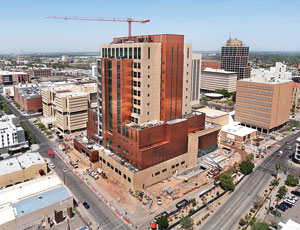To industry giant AECOM, one is an important number. Not only is it the company's rank on ENR's 2011 list of top U.S. design firms, it also is part of the firm's new mantra, “One AECOM,” which represents its efforts to unite employees under a single identity.

AECOM was, until recently, the antithesis of a unified company, with its cornucopia of corporate cultures stitched together from a series of acquisitions and mergers over the past 21 years. In fact, AECOM's largest units still retained their former names–DMJM, EDAW, Earth Tech–until 2009.
After going public (NYSE: ACM) in 2007, AECOM was required to streamline procedures and policies to ensure accurate financial reporting and projections to stockholders. “We looked at it as an opportunity,” says Joey Lake, regional human resources manager. “We had a wealth of knowledge within the practices of AECOM, the regions and its people, so we took what's worked the best and incorporated it into our vision for ‘One AECOM.'”
That meant retiring many of the old company names and merging the marketing, human resources, project management and project delivery systems. “The fundamental structure of the company is [now] designed to encourage collaboration and integration across business lines,” says Bill Vitek, mountain Southwest director for planning, design and development.
“I can't say it's been an easy road,” Lake adds. “Shortly after we started this effort, the economy took a nosedive. But I feel once we get out of this economy, AECOM is poised to do great things because we are laying all the groundwork now, when it's not an easy time to do so.”
The integration efforts are paying off in the Southwest. Revenue from projects in the region exceeded $89 million in 2010, moving the firm up two spots in the regional ranking of design firms and earning it recognition as ENR Southwest's Design Firm of the Year.
While part of the revenue spike resulted from the 2010 acquisition of Tishman Construction (a firm with a strong Las Vegas presence), AECOM has become a market leader in its own right based on prominent projects throughout the Southwest.
Despite its remoteness, Spaceport America—the first commercially built port of its type in the world—is one of AECOM's high profile projects. Located 30 miles from Truth or Consequences, N.M., the $200-million project is “out in the absolute middle of nowhere,” says Alan Jefts, program manager for the project out of AECOM's Houston office. “Everything has to be brought in, including all the utilities.”
AECOM served as programmers on the original site layout and definition of infrastructure, then designed 11 separate components including the site's water and wastewater treatment facilities, electrical systems, airfield, interior roads, fuel storage facility and systems integration package. AECOM also is responsible for commissioning of the terminal hangar facility and ensuring it gains LEED Gold certification upon completion in November.
Jefts says the project benefited from AECOM's varied disciplines, which provided expertise regardless of where the project was geographically. Some of the offices involved included those in Albuquerque, Houston, Orange, Calif., Washington and Philadelphia.
Spaceport America was one of 10 AECOM projects in the Southwest region to pursue LEED certification in 2010, helping the firm bring in 36.8% more sustainable design revenue than in 2009.
AECOM will also seek LEED certification for its new Phoenix office when it is completed later this year. “We are getting candidates interested in working for us because of our position on environmental issues and workplace strategies, which are enabling us to hire the best and the brightest,” says Steve Lichtenberger, principal and manager of architecture in Phoenix. The firm's existing Phoenix location was divided by design discipline, but in the new space, diverse teams will be grouped into project studio workstations, where multiple disciplines can collaborate, Lichtenberger says.
Current Phoenix projects, such as the $65-million future home of the Federal Bureau of Investigation being built by the U.S. General Services Administration, are already benefiting from this type of collaboration. When landscape designers had the idea to shape exterior stone walls and walking paths into a thumb-print pattern to evoke a method used by the FBI to identify criminals, the architects picked up on the idea and incorporated a newer technology—DNA mapping—into the building facade design. “If you aren't working together day in and day out, you miss those sparks for inspiration,” Vitek says.
What’s the Big Idea?
Many of AECOM's projects revolve around a single big idea that acts as an organizing principle. With Civic Space, a multi-purpose park in downtown Phoenix, the idea was to create an “urban weave” of multiple uses, textures and patterns, says Chad Atterbury, landscape designer and associate. Within just 2.5 acres, designers did the equivalent of stuffing “10 pounds of fun into a 5-pound bag,” he says. Each site component has multiple functions: a canopy adorned with photovoltaic panels provides shade and generates electricity, and a plaza with pervious pavement serves as a public gathering area while also channeling valuable water to underground storage tanks. Completed in 2009, the project went on to win numerous accolades, including the national ENR Best of the Best award for landscaping.
Engineering the Future
AECOM's most active sector in 2010 was transportation, with $30.3 million in revenue. The largest current transportation project is Interstate 10 from Prince to Ruthrauff roads in Tucson, Ariz., a project which was actually taken to 95% design level a few years ago, but was shelved until funding became available. The estimated $110-million project is currently out for bid.
To Steven Fowler, vice president and transportation district manager for Arizona and New Mexico, the project that epitomizes the success of the AECOM formula is State Route 179, from Oak Creek to Sedona, completed last year. Previous efforts at improving the roadway were unsuccessful, but with AECOM's assistance, the Arizona Dept. of Transportation implemented a context-sensitive design approach to ensure that everyone involved, including the public, reached consensus on what would be built, Fowler says.
Despite all the mergers and acquisitions, Lake says the core asset for AECOM remains its staff, many of whom have been with the company or its merged firms for a long time, such as Lichtenberger (19 years) and Fowler (30 years).
“I imagine we'll still be acquiring firms and there will still be mergers,” Lake says. “But we'll have a better sense of what AECOM is as a whole company, as opposed to the intricacies of all those different operating companies we might have been at one point.”




Post a comment to this article
Report Abusive Comment